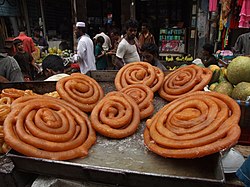This article has multiple issues. Please help improve it or discuss these issues on the talk page . (Learn how and when to remove these messages)
|
 | |
| Alternative names | Jilapi, jilebi, jilbi, jilipi, jelabee, jerry, mushabak, zulbia, z'labia, zalabia, pani walalu |
|---|---|
| Course | Dessert |
| Place of origin | West Asia Regional variants:
|
| Region or state | West Asia, Indian subcontinent, Africa |
| Serving temperature | Hot or cold |
| Main ingredients | Maida flour or yeasted dough, saffron, ghee, sugar or honey |
| Variations | Sesame oil, sesame seeds, yogurt, cinnamon, lemon, cardamon; different shapes |
| Similar dishes | Afghan jalebi, chhena jalebi, imarti, shahi jilapi, bamiyeh, lokma, zalabiyeh |
Jalebi is a common sweet snack in the Indian subcontinent, West Asia and some parts of Africa. It goes by many names, including jilapi, zelepi, jilebi, jilipi, zulbia, zoolbia, jerry, mushabak, z'labia, or zalabia.
Contents
- History
- Regional varieties
- Central Asia
- Indian subcontinent
- West Asia
- Africa
- Mauritius
- Recipe variations
- In popular culture
- See also
- References
The south Asian variety is made by deep-frying maida flour (plain flour or all-purpose flour) batter in pretzel or circular shapes, which are then soaked in sugar syrup. Jalebi is eaten with curd or rabri (in North India) along with optional other flavors such as kewra (pandanus flower essence).
In some west Asian cuisines, jalebi may consist of yeast dough fried and then dipped in a syrup of honey and rose water.[ citation needed ] North African zalabia uses a different batter and a syrup of honey (Arabic: ʻasal) and rose water. [5]







